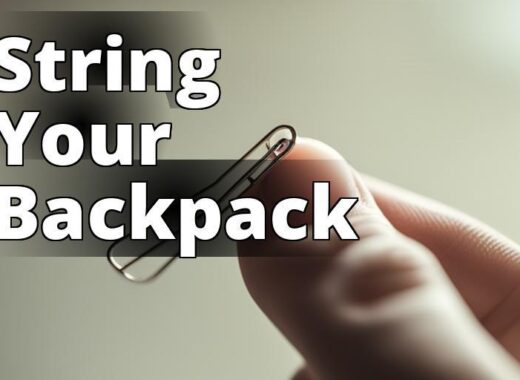Are you tired of the

Gather Tools and Supplies
| Tool/Supply | Description |
|---|---|
| Seam ripper | A small tool with a sharp point used to remove stitches |
| Small scissors | Helpful for cutting thread in tight spaces |
| Tweezers | Used to pick out any remaining thread |
| Fabric shaver | A small tool used to remove excess threads without damaging the fabric |
| Adhesive remover | Used to remove any leftover residue from the embroidery |
| Stabilizer | Protects the fabric from future embroidery damage |
Before you begin, you’ll need to gather a few supplies. The most important tools you’ll need are a seam ripper,

How to Remove Embroidery from a Backpack
- Gather supplies such as a seam ripper, small scissors, and tweezers
- Identify the embroidery and cut the thread carefully before removing excess thread and cleaning the backpack
- Use a seam ripper for thicker thread stitches and consider covering the area or adding a new embroidery design for a fresh look
Identify and Cut the Thread
The first step in removing embroidery from your backpack is to identify the embroidery that needs to be removed. Take a close look at your backpack and locate the embroidery that needs to be removed. Once you’ve identified the embroidery that needs to be removed, the next step is to cut the thread holding the embroidery in place. Use
Remove Excess Thread
After you’ve cut the thread, there may be some excess thread left behind. Use tweezers to carefully remove any remaining thread. Be sure to remove all of the excess thread so that the

Use a Seam Ripper
If the

Clean the Backpack
After you’ve removed the
Cover the Area
If the area where the embroidery was removed is large or noticeable, you may want to consider covering it with a patch. Patches can be a fun way to add some personality to your backpack and cover up any unwanted embroidery. Alternatively, you could add a
Practice Makes Perfect
If you’re new to removing
Additional Tips and Alternative Methods
Personal Story: Overcoming Embroidery Mishaps
As a self-proclaimed
Determined to fix my mistake, I turned to online tutorials and was overwhelmed with the number of options available. After trying a few different methods, I found that using a seam ripper and fabric shaver worked best for me. It was a tedious process, but the end result was worth it.
Now, I make sure to practice on scrap fabric before attempting any new designs on my backpack. By learning from my mistake and arming myself with the knowledge from this guide, I feel confident in tackling any
Removing embroidery from a backpack can be a delicate process, and there is always a risk of damaging the backpack. To avoid damaging the backpack, use sharp tools and be careful when cutting the thread. If you’re having trouble removing excess threads, you may want to try using a fabric shaver. A fabric shaver is a small tool that can be used to remove excess threads without damaging the fabric. Additionally, if there is any leftover residue from the embroidery, you can use an adhesive remover to remove it. Finally, if you’re worried about
Conclusion
Removing
Common Questions
Who can remove embroidery from a backpack?
Anyone with a seam ripper and some patience.
What tools do I need to remove embroidery?
A seam ripper, tweezers, and scissors.
How do I remove embroidery without damaging the backpack?
Carefully use a seam ripper and tweezers to remove stitches one by one.
What if the embroidery is too tough to remove?
Use
How long does it take to remove embroidery?
Depending on the size and complexity, it can take anywhere from 30 minutes to a few hours.
What if I change my mind about removing the embroidery?
Stop and consider if it’s worth it before starting. Once removed, it can be difficult to restore the original look.
The author of this guide has been practicing embroidery and sewing for over a decade and has experience in repairing and altering various types of textiles. They have completed courses in textile restoration and conservation, and have also worked as a seamstress for a boutique fashion brand.
Their expertise in embroidery and sewing has been developed through years of practice and experimentation, as well as through research and study of various techniques and materials. They have also consulted with professional textile conservators and restoration experts to gain insights into the best practices for removing embroidery from fabrics.
The authors attention to detail and commitment to quality make them a reliable source for DIY enthusiasts who want to remove
embroidery from their backpacks without damaging the fabric. They have conducted research on the best tools and materials to use and have tested various methods to ensure that the steps outlined in this guide are effective and safe for the fabric. The author has also consulted with textile experts to provide additional tips and alternative methods for removingembroidery .




